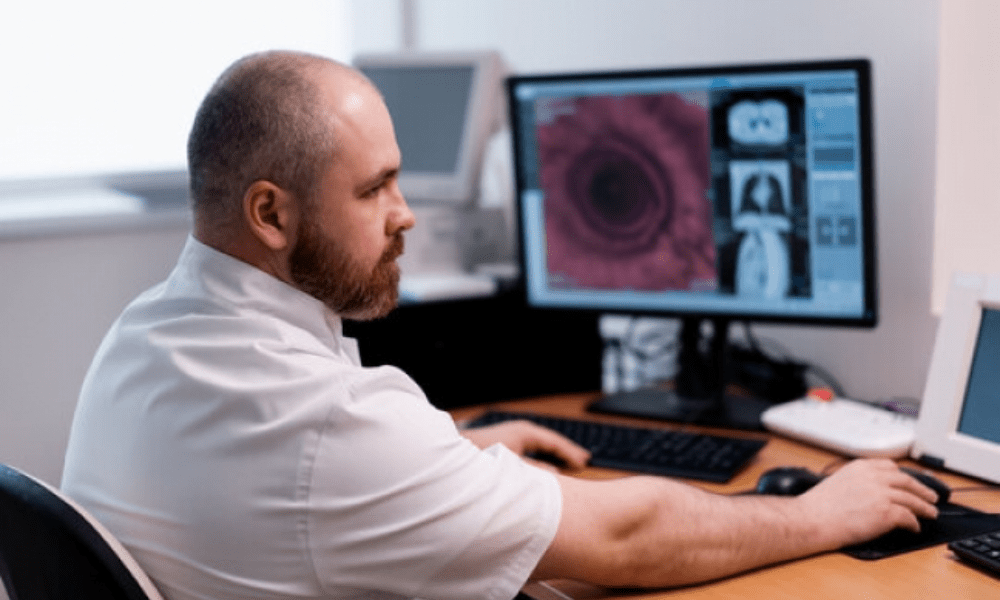Computer imaging is a field of computer science that brings together different techniques related to the production, processing, indexing, and compression of digital images. A digital image is a binary representation of an image, consisting of a matrix of points called pixels, which can have different dimensions ( spatial, temporal, etc. ) and different coding levels ( colors, gray levels, etc. ) .
Computational imaging has many applications in various fields, such as image synthesis, virtual reality, augmented reality, 3D modeling image processing video processing , video editing , compression , computer vision , image search by content , or even video games .
In this article, we will introduce you to the basic principles of computer imaging, types of digital images, methods of image processing and analysis, as well as the main areas of application of this technology .
What are the types of digital images?

Computer imaging relies on three main stages: acquisition , transformation and visualization of digital images .
Acquisition of digital images
Digital image acquisition involves converting an analog image (for example, a photograph or a real scene) into a digital image. To do this, we must use devices capable of capturing light and transforming it into electrical signals, then into binary data. These devices are called sensors or analog-to-digital converters. There are different types of sensors, depending on the type of image to be acquired ( still or moving image, color or black and white image, etc.) and depending on the field of application (photography, video, scanner, thermal camera, etc.).
Transformation of digital images

The transformation of digital images consists of modifying the binary data that represents the image, in order to improve its quality, extract relevant information, or create new ones. To do this, you must use computer programs that apply specific algorithms to digital images. These programs are called imaging software or graphics tools. There are different types of imaging software, depending on the type of transformation to be performed (correction, filtering, segmentation, edge detection, shape recognition, etc.) and depending on the field of application (photo editing, video editing, synthesis) . image , etc.).
Viewing digital images
Viewing digital images involves displaying the digital image on a suitable medium, such as a computer screen, printer or projector. To do this, it is necessary to use devices capable of converting binary data into electrical or optical signals which will stimulate the elements of the support. These devices are called digital-to-analog converters. There are different types of digital-to-analog converters , depending on the type of media used (LCD screen, OLED screen, inkjet printer, laser printer, etc.) and depending on the desired viewing mode (2D or 3D image, stereoscopic image or holographic, etc.)
What are the types of digital images?

There are different types of digital images, depending on how the pixels are encoded and organized. We can distinguish two main categories: raster images and vector images.
Raster images
Raster images are images made up of a grid of pixels, each pixel of which has a value that represents its color or gray level. Raster images are suitable for representing realistic images, with fine details and color nuances. They are also easy to manipulate with imaging software , which can apply pixel-by-pixel transformations. However, raster images also have disadvantages: they take up a lot of memory space, they are susceptible to noise and compression artifacts, and they lose quality when enlarged or reduced.
There are different file formats for storing raster images, such as J PEG, PNG, GIF, BMP, TIFF, etc. These formats can be classified according to whether they are compressed or uncompressed, and whether they are lossy or lossless. A compressed format reduces the file size by eliminating certain redundant or barely perceptible information. A lossy format removes information that may alter the quality of the image, while a lossless format retains all information.
Vector images

Vector images are images consisting of geometric objects, such as points, lines, curves, polygons, etc., each object of which has attributes that define its position, shape, color, fill, etc. . Vector images are suitable for representing simple images , with regular shapes and uniform colors. They are also easy to modify with vector drawing software , which can apply geometric transformations to objects. In addition, vector images have the advantage of occupying little memory space, being insensitive to noise and compression, and maintaining their quality regardless of the zoom level .
There are different file formats for storing vector images , such as SVG, EPS, PDF, WMF, etc. These formats can be classified according to whether they are standard or proprietary, and whether or not they are compatible with web browsers. A standard format is a format that follows an open standard and can be read by different software. A proprietary format is one that is owned by a company or organization and may require specific software to play. A web browser compatible format is one that can be displayed directly on a web page without the need for a plugin or external application .
What are the methods of processing and analyzing digital images?
The processing and analysis of digital images consists of applying operations to digital images in order to improve their quality, extract useful information or create new ones . There are different methods of processing and analyzing digital images, depending on the type of image (matrix or vector), the domain (spatial or frequency), the purpose (correction, filtering, segmentation, edge detection, shape recognition , etc. ) and the level (low level, medium level or high level).
Processing and analysis of raster images

The processing and analysis of raster images can be done in two different domains: the spatial domain and the frequency domain.
The space domain
The spatial domain corresponds to the domain in which the pixels are arranged according to their position in the image . The processing and analysis of raster images in the spatial domain consists of applying operations directly on the pixel values, without going through a prior transformation . These operations can be of different types, such as:
- Correction , which aims to improve image quality by changing parameters such as brightness, contrast, color balance, etc.
- Filtering , which aims to reduce noise or accentuate certain details in the image by using masks or filters that modify pixel values based on their neighbors.
- Segmentation or meaningful regions according to criteria such as color, texture, intensity, etc.
- Edge detection , which aims to identify boundaries between image regions using operators that calculate the gradient or variation in pixel intensity.
- Pattern recognition , which aims to identify and classify objects present in the image using techniques such as pattern comparison, feature description, machine learning, etc.
The frequency domain
The frequency domain corresponds to the domain in which the pixels are arranged according to their frequency or their periodicity in the image. Processing and analysis of raster images in the frequency domain involves applying operations after transforming the image from the spatial domain to the frequency domain. This transformation makes it possible to represent the image as a sum of sinusoidal functions of different frequencies and amplitudes. Low-frequency sine functions correspond to overall variations in the image, while high-frequency sine functions correspond to fine image details. Operations in the frequency domain can be of different types, such as:
- Compression , which aims to reduce file size by eliminating sinusoidal functions which have little impact on the visual perception of the image .
- Filtering , which aims to reduce noise or accentuate certain details of the image by using filters which modify the amplitudes of the sinusoidal functions according to their frequency.
- Restoration , which aims to improve image quality by correcting distortions caused by the sensor or digital-to-analog converter .
- Pattern recognition , which aims to identify and classify objects present in the image using techniques such as cross-correlation, Hough transform, wavelet transform, etc.
Processing and analysis of vector images

The processing and analysis of vector images consists of applying operations to the geometric objects that make up the image. These operations can be of different types, such as:
- Geometric transformation , which aims to change the position, size, orientation or shape of geometric objects using matrices or mathematical functions.
- Coloring , which aims to change the color or fill of geometric objects using attributes or gradients.
- The creation of complex objects , which aims to combine several simple geometric objects using Boolean operations (union, intersection, difference, etc.) or deformation operations (curvature, twist, etc.).
- Rasterization , which aims to convert a vector image into a raster image by calculating the pixel values that correspond to geometric objects.
- Vectorization , which aims to convert a raster image into a vector image by detecting the contours and regions of the image and approximating them with geometric objects.
What are the main areas of application of computational imaging?

Computer imaging has many applications in various fields, which can be grouped into three broad categories: the creation, communication and understanding of digital images .
Creating digital images
Digital image creation consists of producing original images or modifying existing images for artistic, recreational or educational purposes. Areas of application for digital image creation include:
- Image synthesis , which involves generating images from mathematical models or digital data, using techniques such as ray tracing, non-photorealistic rendering, procedural generation, etc.
- Virtual reality , which consists of creating and simulating an immersive and interactive environment in which the user can move and act, using devices such as the virtual reality headset, data glove, treadmill, etc.
- Augmented reality , which consists of superimposing virtual elements on a real image, using devices such as smartphones, tablets, connected glasses, etc.
- 3D modeling , which consists of creating and manipulating three-dimensional objects from geometric primitives or point clouds, using software such as Blender, Maya, SketchUp, etc.
- Video editing , which involves assembling, cutting, modifying or adding effects to video sequences, using software such as Adobe Premiere Pro, Final Cut Pro, iMovie, etc.
- Video games , which consist of creating and playing interactive and fun scenarios in which the player controls one or more characters or objects, using platforms such as the game console, computer, smartphone, etc.
Digital image communication

Digital image communication consists of transmitting or disseminating images through different media or networks, for informational, advertising or social purposes. The areas of application of digital image communication include:
- Compression storage or transmission.
- Cryptography , which involves protecting images from unauthorized access or malicious modification, using techniques such as encryption, digital watermarking, digital signing, etc.
- Content-based image search , which consists of finding images that are similar or relevant to a textual or visual query, using techniques such as visual feature extraction , keyword indexing, similarity visual, ranking by relevance, etc.
- Facial recognition , which involves identifying or verifying the identity of a person from their face, using techniques such as feature point detection, pattern comparison, deep learning, etc.
- Social networks , which consist of sharing or commenting on images with other users, using platforms such as Facebook, Instagram, Snapchat, etc.
Understanding digital images

understanding involves analyzing or interpreting images for scientific, medical or industrial purposes. The areas of application for understanding digital images include:
- Computer vision , which involves simulating human visual perception and extracting semantic or geometric information from images, using techniques such as semantic segmentation, object detection, motion tracking, 3D reconstruction, etc. .
- Medical imaging , which involves producing or analyzing images of the human body for diagnostic or treatment purposes, using techniques such as radiography, ultrasound, MRI, tomography , etc.
- Scientific imaging , which involves producing or analyzing images of natural or artificial phenomena for research or exploration purposes, using techniques such as microscopy, spectroscopy, remote sensing, astrophotography, etc.
- Industrial imaging , which involves producing or analyzing images of industrial products or processes for quality control or safety purposes, using techniques such as machine vision, non-destructive testing, infrared thermography , etc. .
Conclusion
Computational imaging is an exciting and evolving field , which offers many possibilities for creating, communicating and understanding digital images. Whether for entertainment, information or science, computer imaging makes it possible to produce and manipulate images of unparalleled quality and richness. However, computer imaging also poses challenges and ethical issues, such as respect for privacy, copyright or the veracity of images. It is therefore important to train in the principles and techniques of computer imaging, but also to develop a critical and responsible mindset when dealing with digital images. Business intelligence , for example, is one of the disciplines that relies on computational imaging to analyze and visualize complex and large data, to aid decision-making in various application areas.




